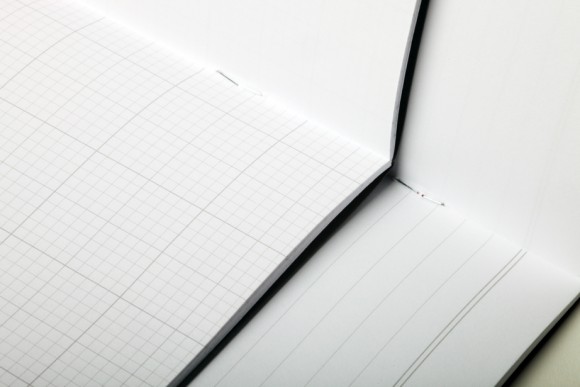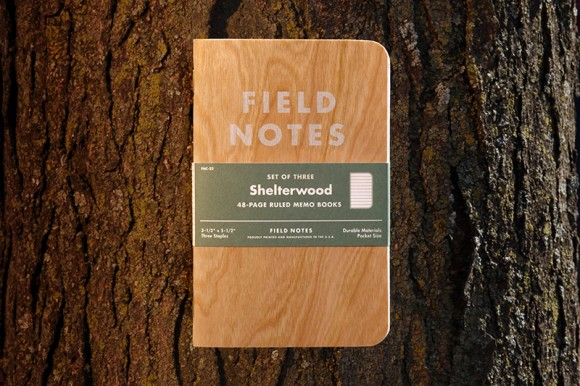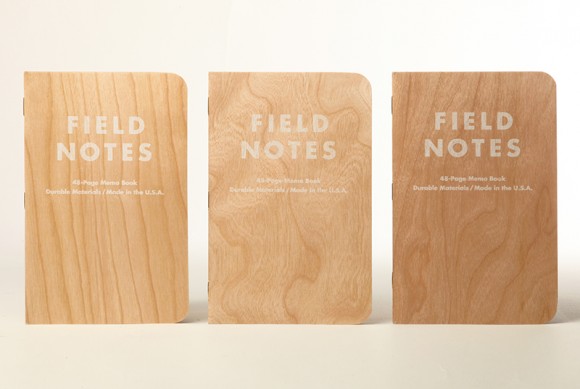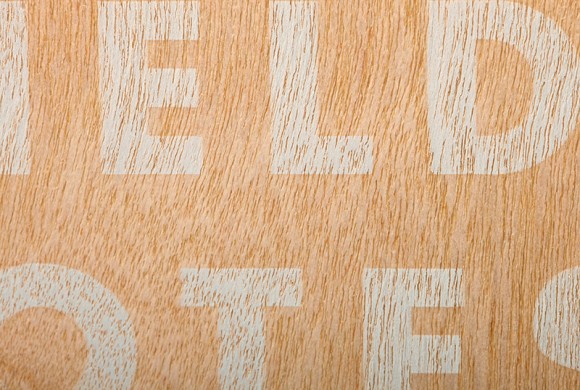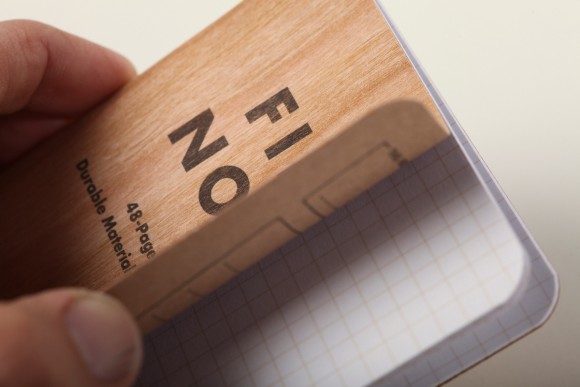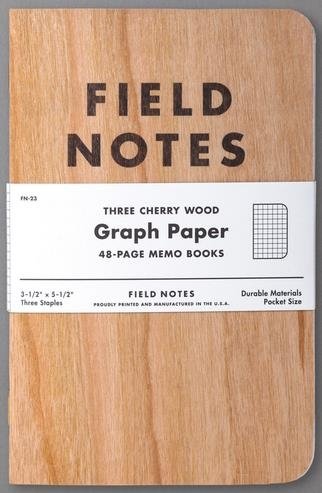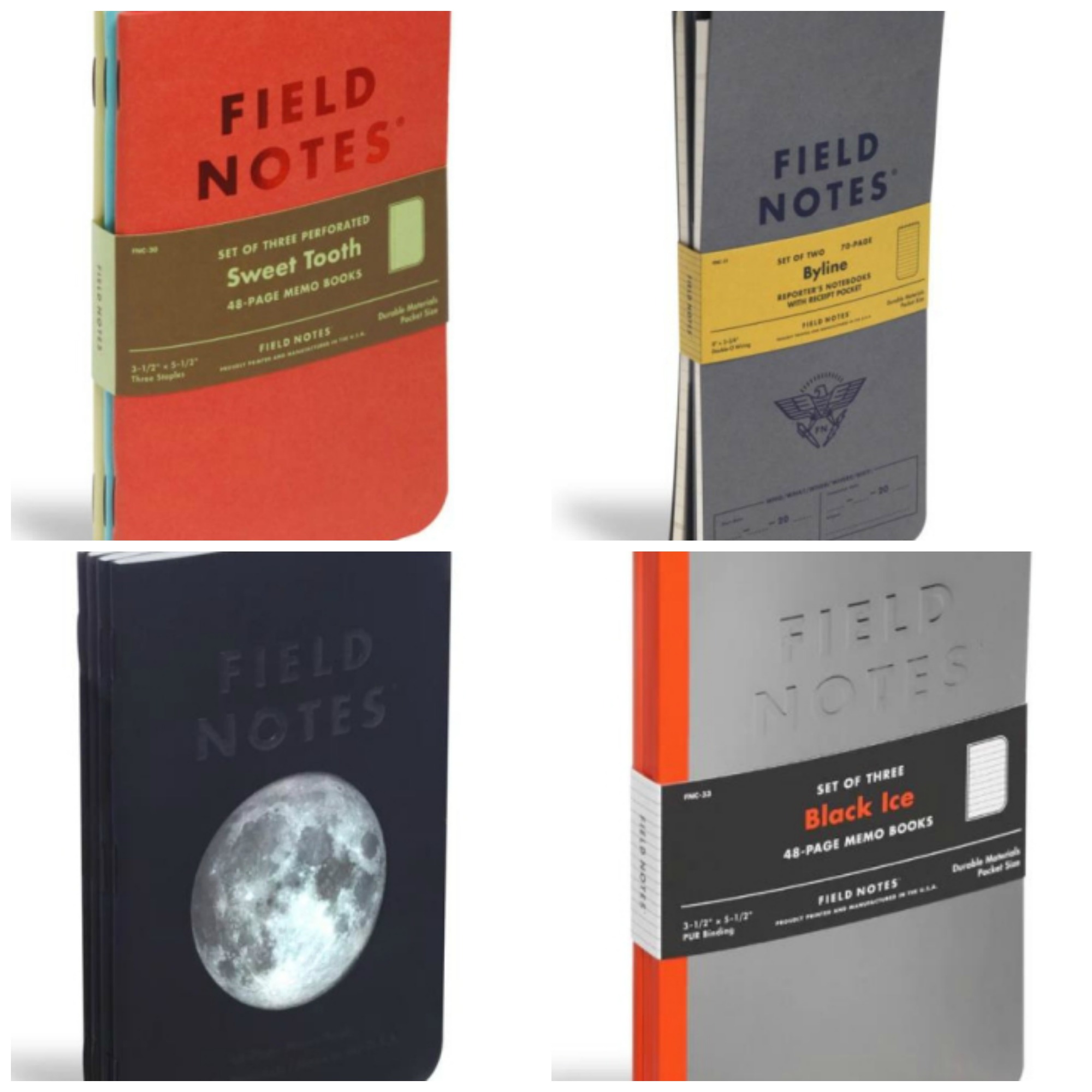
The Field Notes 2016 limited editions are now available for purchase on our website. Take this opportunity to grab hold of the following:
Field Notes Sweet Tooth, Spring 2016
Field Notes Byline, Summer 2016
Field Notes Lunacy, Fall 2016
Field Notes Black Ice, Winter 2016
FIELD NOTES WINTER 2016 EDITION: BLACK ICE
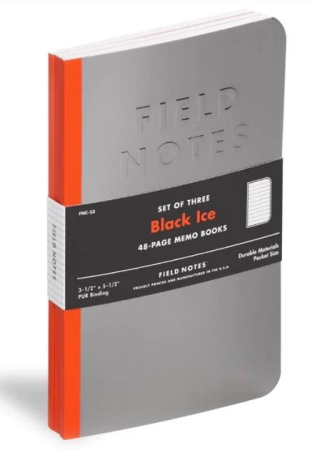
From Field Notes:
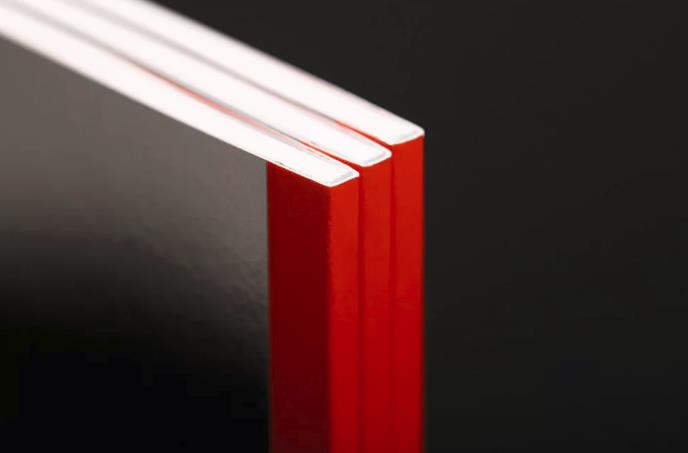
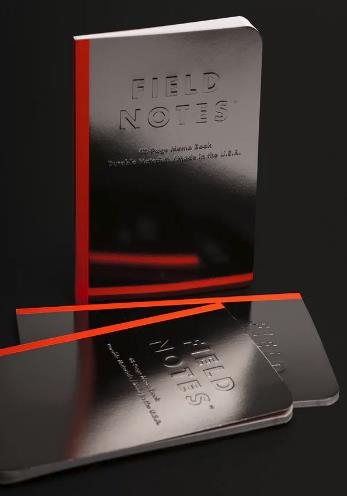
It all turned out to be a very complicated printing process, involving a lot of testing, lots of steps, many press checks and some serious challenges for our printers. In the end, they came through and really nailed it. These books look simply amazing.
FIELD NOTES FALL 2016 EDITION: LUNACY
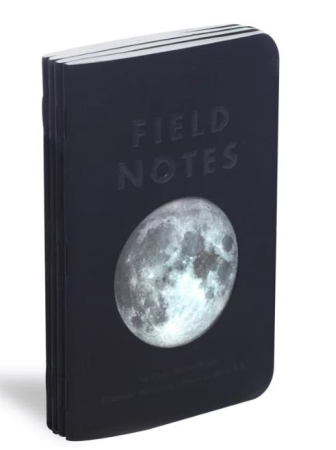
From Field Notes:
Our 32nd Quarterly Edition for Fall, 2016 is a perfect example of an idea that started simply and then got a bit out of hand. Okay, maybe more than a bit. Originally, our basic concept was to do a 3-Pack of Memo Books celebrating the Harvest Moon. Then somebody asked, “What about highlighting the phases of the Moon?” Somebody else said “DIE-CUT!” which was followed quickly by a chorus of “Matte Varnish!” “Embossing!” and “Let’s make sure that people know how to avoid becoming a werewolf.”
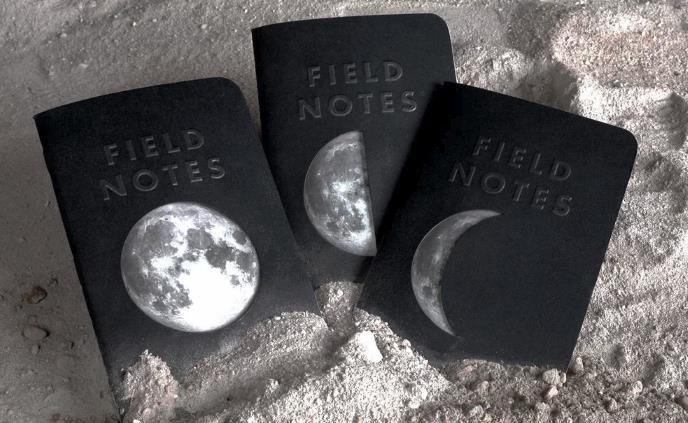
This is the aptly-titled “Lunacy” Edition. There’s lots to love about this release. The embossed covers are made from Neenah’s Classic Crest “Epic Black Stipple” which features a gorgeous, almost leathery finish. For the first time ever, we’ve die-cut the covers, using individual dies for each of the three books. One reveals a full moon, one a half moon, and one a crescent.
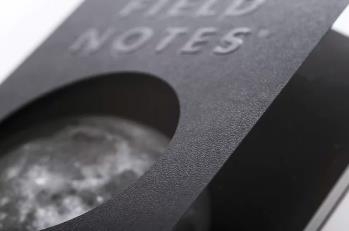 The moon that’s visible through the die-cut is printed in 4-color on a glossy flyleaf which also includes facts and folklore about earth’s constant companion, as well as a lovely shot of the dark side of the moon in the back of the books. The Field Notes logo is embossed with a subtle hit of varnish, and the back cover features an embossed full moon. The books are bound with black staples (of course), and the 48 body pages feature a reticle pattern on light grey “Moondust” pages.
The moon that’s visible through the die-cut is printed in 4-color on a glossy flyleaf which also includes facts and folklore about earth’s constant companion, as well as a lovely shot of the dark side of the moon in the back of the books. The Field Notes logo is embossed with a subtle hit of varnish, and the back cover features an embossed full moon. The books are bound with black staples (of course), and the 48 body pages feature a reticle pattern on light grey “Moondust” pages.
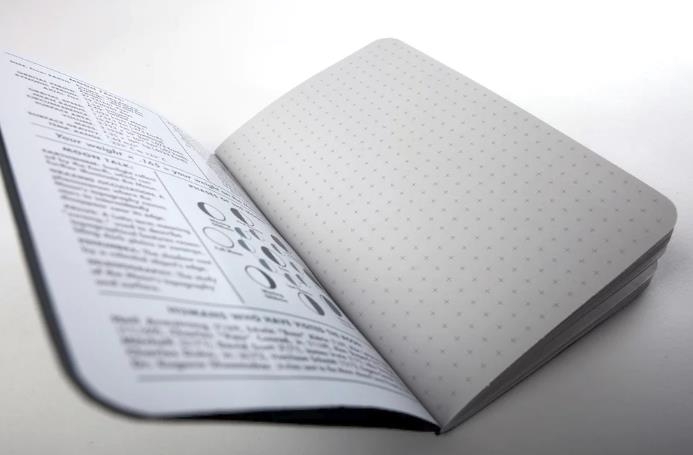
“Lunacy” is available now in 3-Packs featuring full, half, and crescent moons.
FIELD NOTES SUMMER 2016: BYLINE
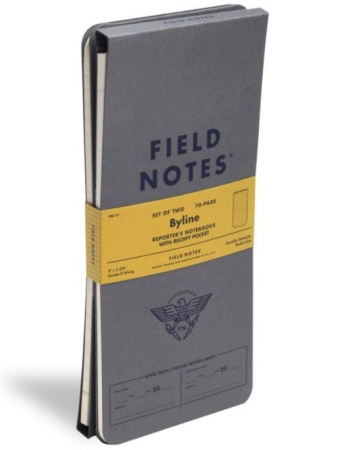
Field Notes is proud to present their 31st limited release: The “Byline” Edition, for Summer 2016. You’ll find they’re excellent for taking notes at work or in class. They’re Wire-O-Bound and lay flat, so they’re perfect on your desk or kitchen counter, or on that table near the door where you always leave your keys. And of course, if you’re getting the scoop on deep-background from an anonymous source for your next big front page story, well then, the “Byline” Edition is just the ticket. As usual, the inside covers are jam-packed with helpful information.
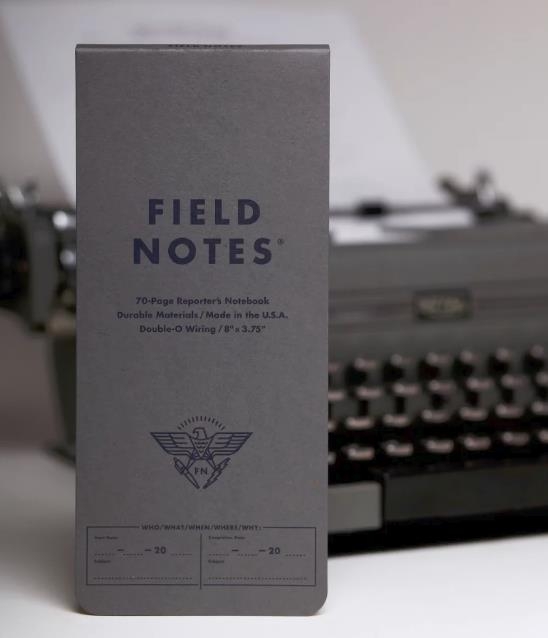
We studied existing Reporter’s Notebooks and updated and improved just about every facet of the design. Classic Reporter’s Notebooks have always felt a touch clumsy in our hands. We’ve trimmed the width a hair to make it easier to write with one hand while holding it with the other.
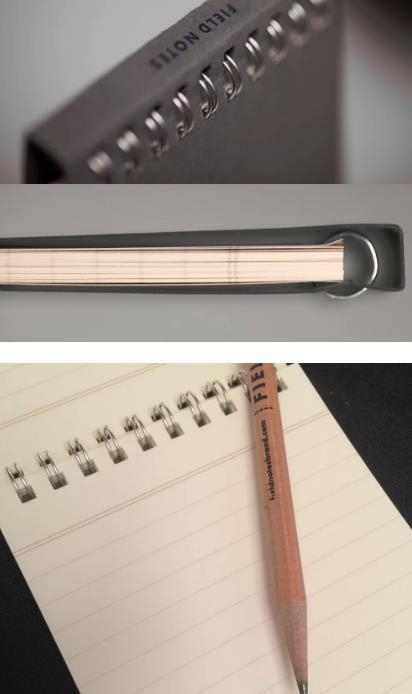
We’ve created a cover which protects the wire binding, so it doesn’t get caught on fabric or stuff in your backpack. Traditional notebooks are Gregg-ruled which, to our eyes, is too wide and too dark. We’ve moved to a lighter Collegiate ruling. The diameter of the binding has been customized, as have the die-cut holes that the binding passes through, for maximum “flippability.”
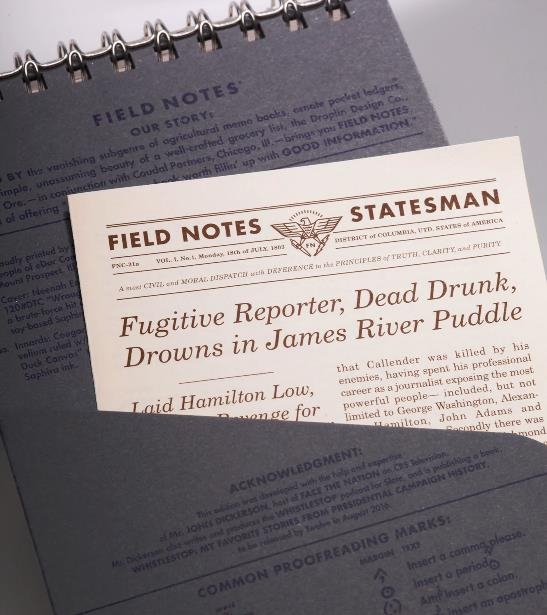
A handy pocket has been added to the back cover which makes for a thicker and more stable hand-held writing surface, and also gives you a place to stash a shred of evidence or a receipt for the cocktails you bought to ply a reluctant witness.
FIELD NOTES SPRING 2016: SWEET TOOTH
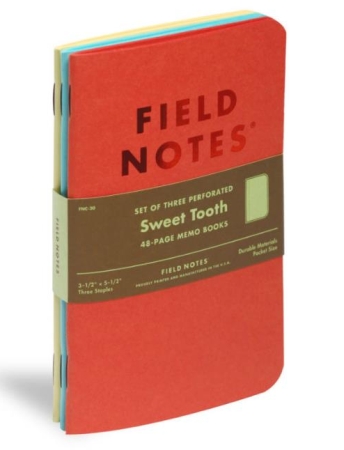
From Field Notes:
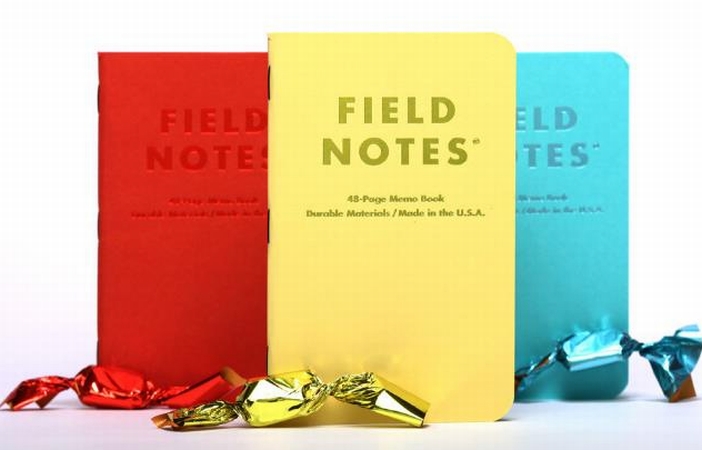
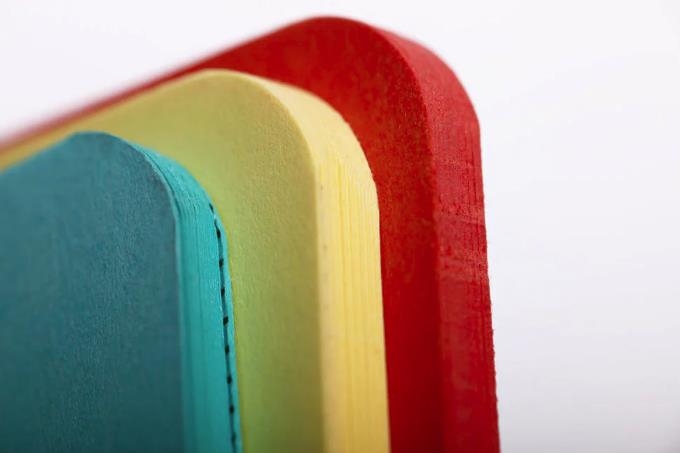
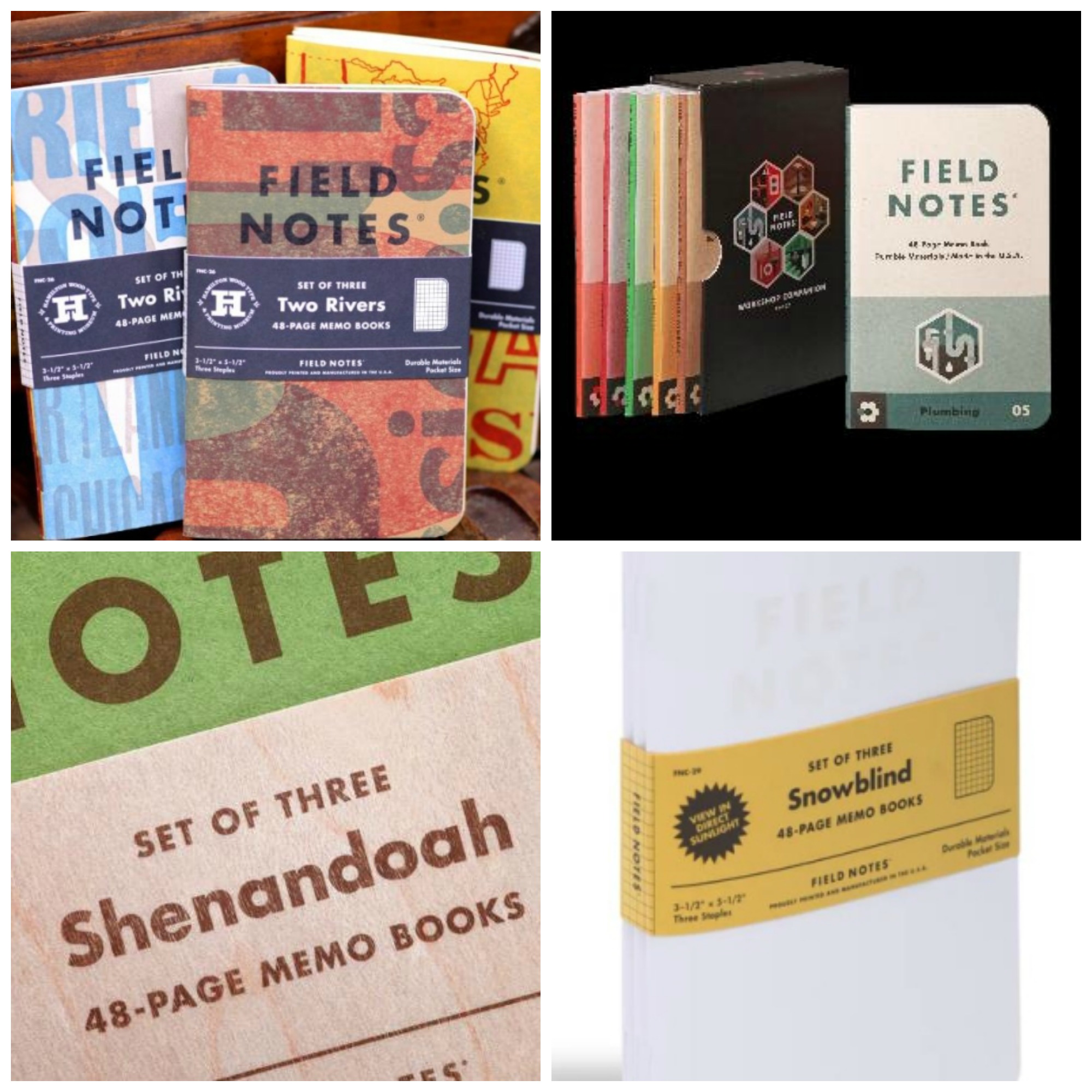
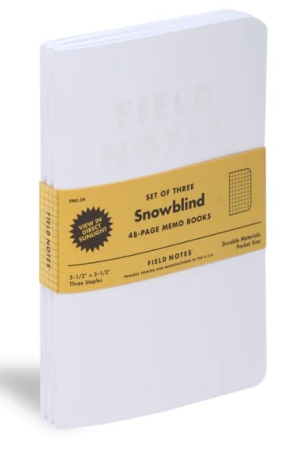
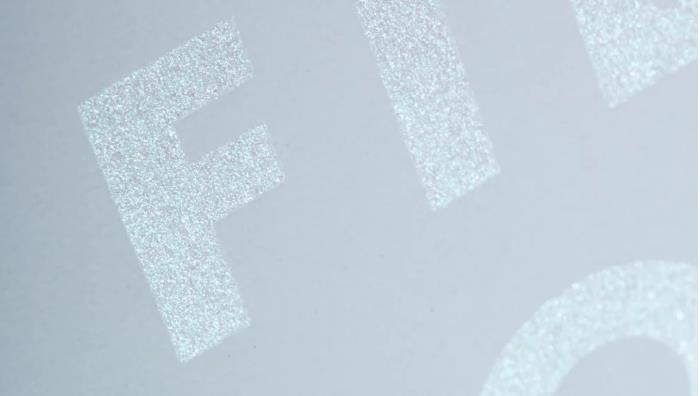
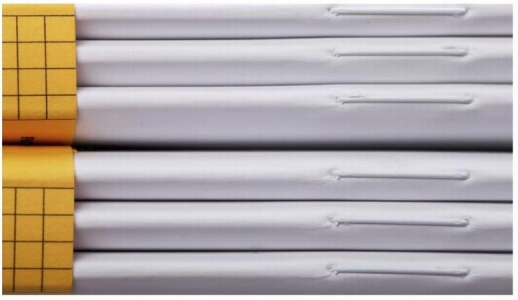
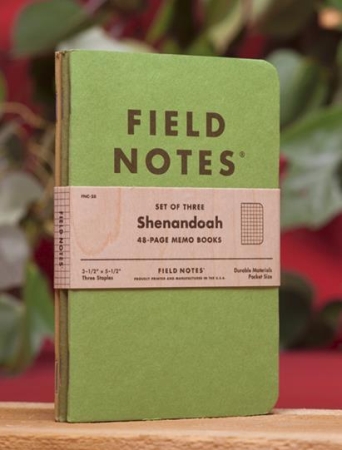
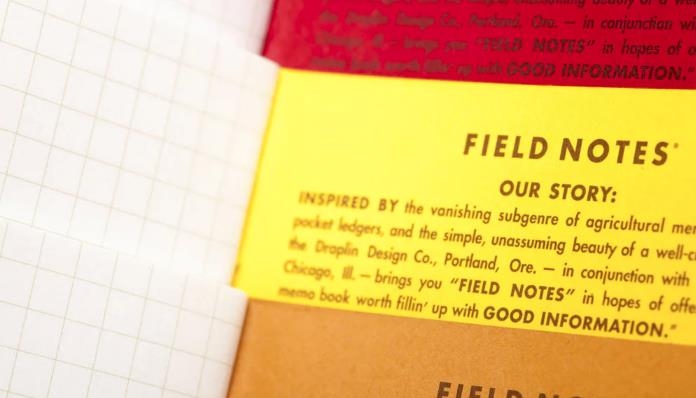
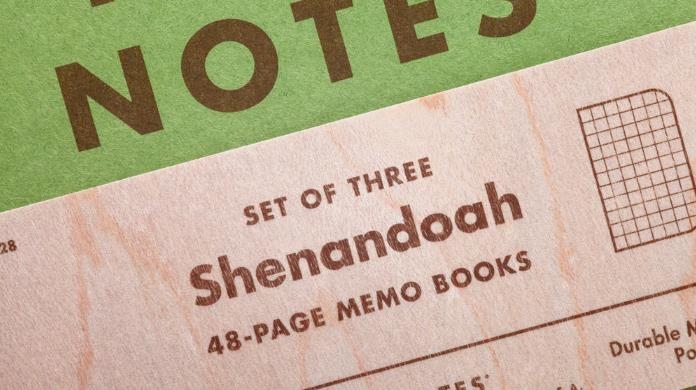
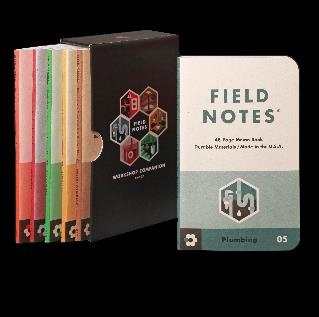
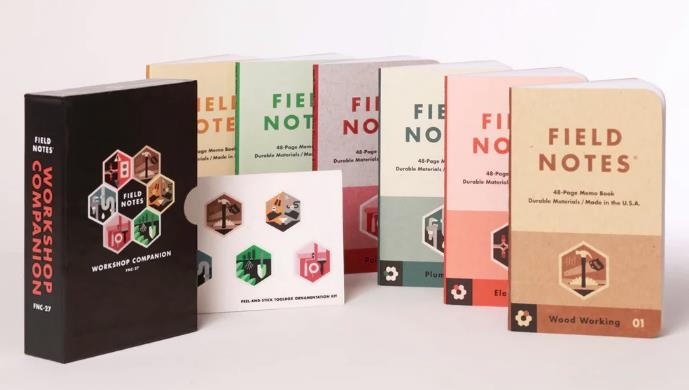
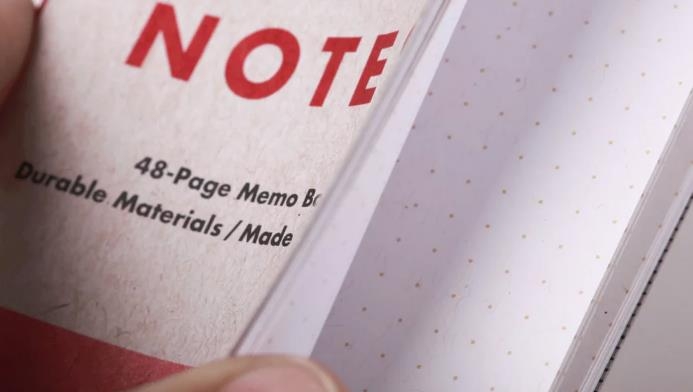
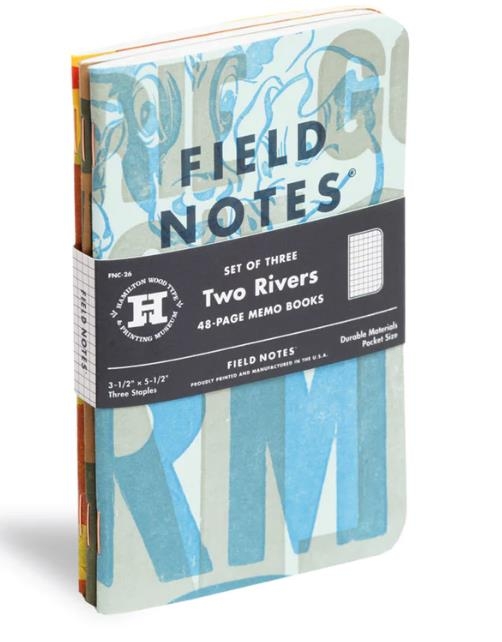
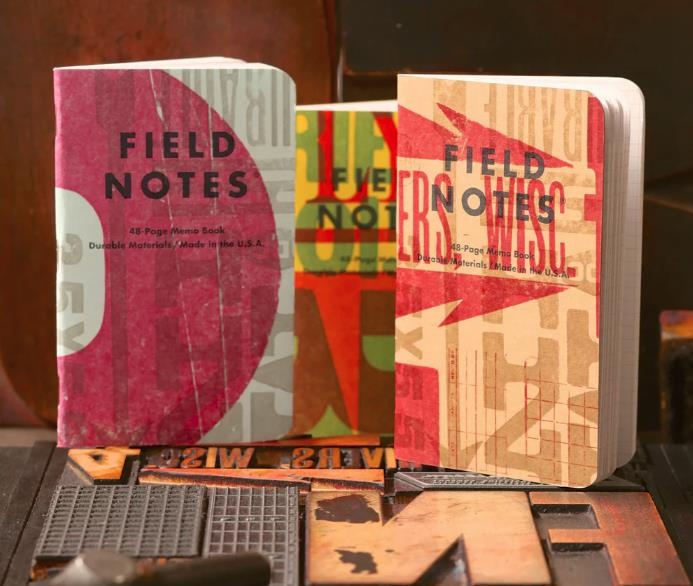
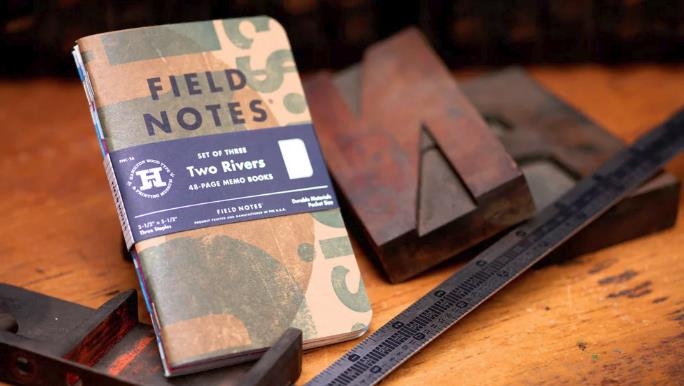
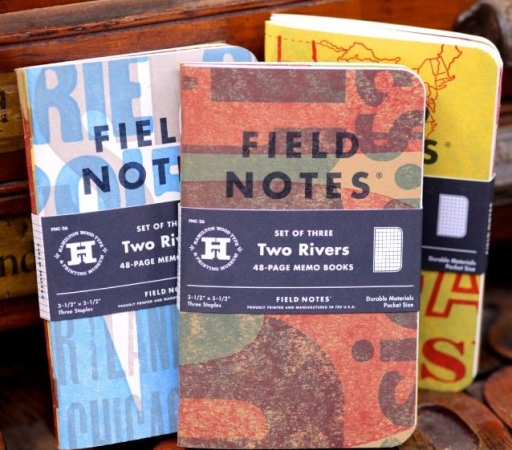
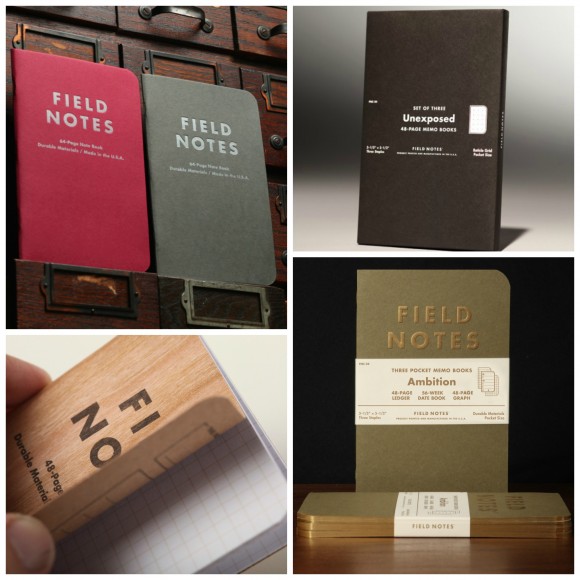
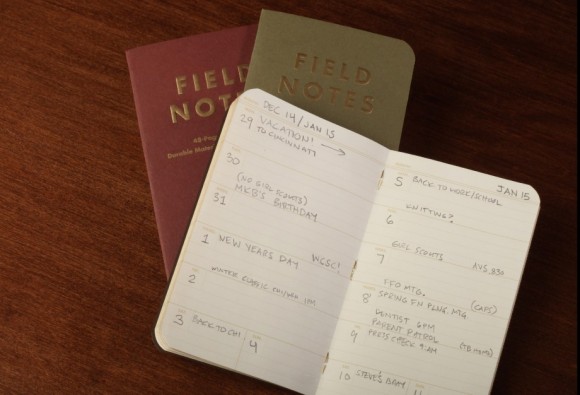
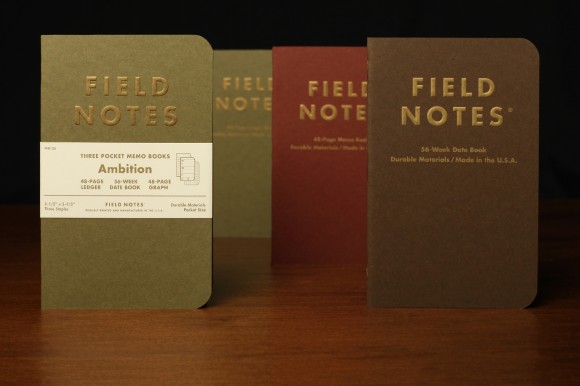 Our old friends French Paper Co. of Niles, Michigan supplied “Olive,” “Wine,” and “Chocolate” 100# Speckletone for the covers, with production bouncing around the Midwest for the last few weeks. Printing started in Chicago’s suburbs at eDoc, then the covers were delivered to Nu Wave Diecutting & Finishing in downtown Chicago to emboss the cover logo. After a trip back to eDoc for bindery, they were trucked down to Liberty Book and Bible in Indianapolis for a process nearly as old as bookbinding, but all-new to us!
Our old friends French Paper Co. of Niles, Michigan supplied “Olive,” “Wine,” and “Chocolate” 100# Speckletone for the covers, with production bouncing around the Midwest for the last few weeks. Printing started in Chicago’s suburbs at eDoc, then the covers were delivered to Nu Wave Diecutting & Finishing in downtown Chicago to emboss the cover logo. After a trip back to eDoc for bindery, they were trucked down to Liberty Book and Bible in Indianapolis for a process nearly as old as bookbinding, but all-new to us!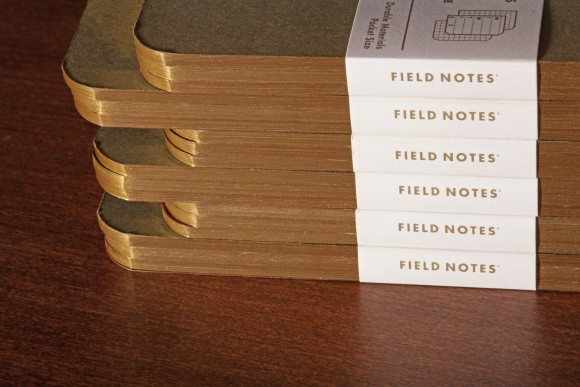 Gilding is an ancient technique once performed by artisans with gold leaf, mallets, and secret mixtures of binding paste. A century or so ago the process was mechanized, but it’s still ridiculously complex. The books are clamped into small batches, then make three passes (once for each edge) through an Ochsner edge gilder, which sands the edges smooth with varying grits of sandpaper, then fuses metallic foil to the edge with heat. It was certainly the strangest piece of printing machinery we’d seen, until a few minutes later when we saw a pair of Ochsner round-corner gilding machines in action.
Gilding is an ancient technique once performed by artisans with gold leaf, mallets, and secret mixtures of binding paste. A century or so ago the process was mechanized, but it’s still ridiculously complex. The books are clamped into small batches, then make three passes (once for each edge) through an Ochsner edge gilder, which sands the edges smooth with varying grits of sandpaper, then fuses metallic foil to the edge with heat. It was certainly the strangest piece of printing machinery we’d seen, until a few minutes later when we saw a pair of Ochsner round-corner gilding machines in action.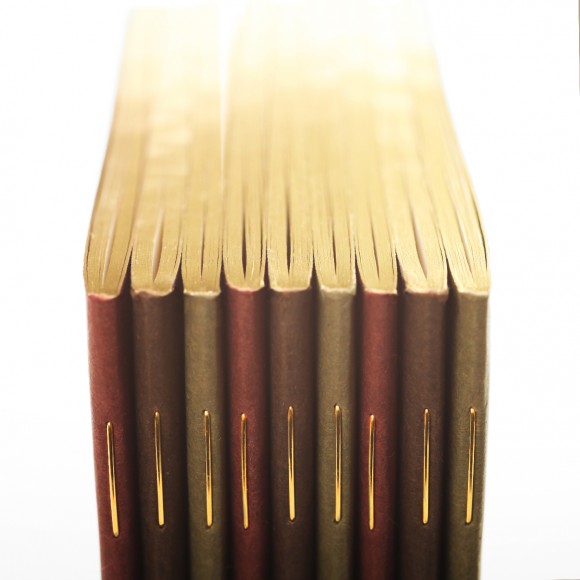 But that’s not the only FIELD NOTES first in this edition. The “Olive” book is ruled in ledger lines (which you may remember from FNC-16, “Traveling Salesman”), and the “Wine” book is graph paper, but the “Chocolate” book features 56 pages ruled in a weekly datebook format! The body paper is Cougar Opaque 50# “Natural White” text-weight vellum printed in “Double Knee Duck Canvas” ink. With all that gold going on, gold staples were the obvious choice to hold the books together.
But that’s not the only FIELD NOTES first in this edition. The “Olive” book is ruled in ledger lines (which you may remember from FNC-16, “Traveling Salesman”), and the “Wine” book is graph paper, but the “Chocolate” book features 56 pages ruled in a weekly datebook format! The body paper is Cougar Opaque 50# “Natural White” text-weight vellum printed in “Double Knee Duck Canvas” ink. With all that gold going on, gold staples were the obvious choice to hold the books together.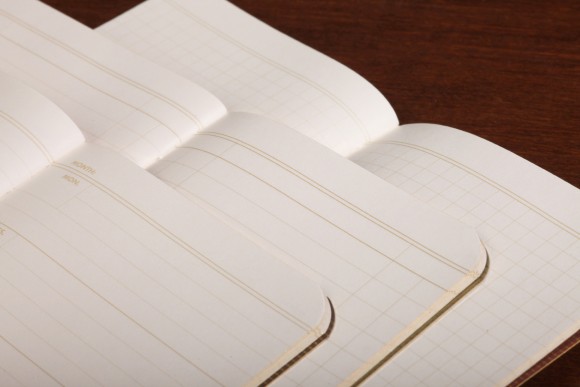 With a datebook, ledger, and memo book in hand, projects of any scope become more manageable. And we bet the elegant gilded edges will help get you out of bed a bit earlier and start getting things done. All that’s standing between you and your goals are a whole bunch of notes, facts, lists, and figures, and now you have the perfect place to write it all down.
With a datebook, ledger, and memo book in hand, projects of any scope become more manageable. And we bet the elegant gilded edges will help get you out of bed a bit earlier and start getting things done. All that’s standing between you and your goals are a whole bunch of notes, facts, lists, and figures, and now you have the perfect place to write it all down.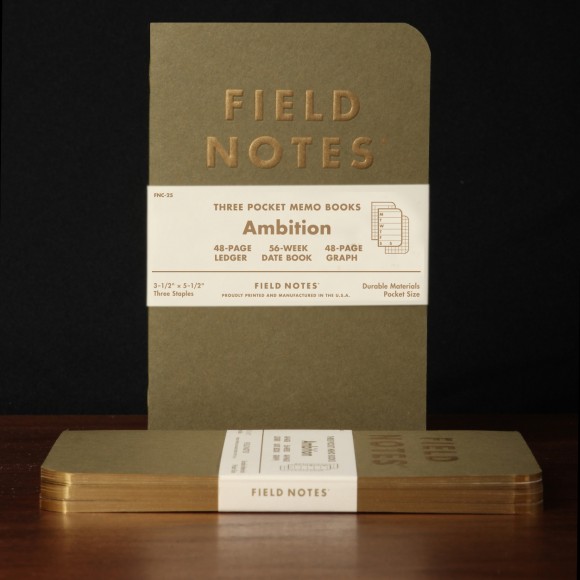
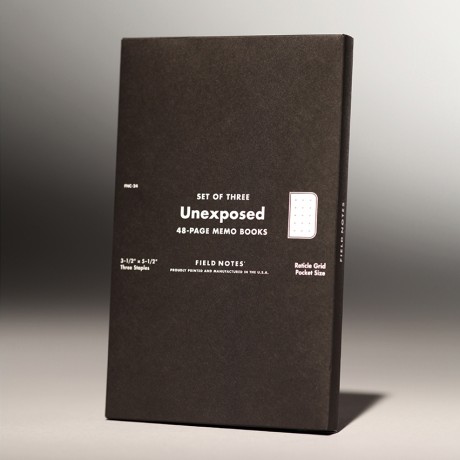
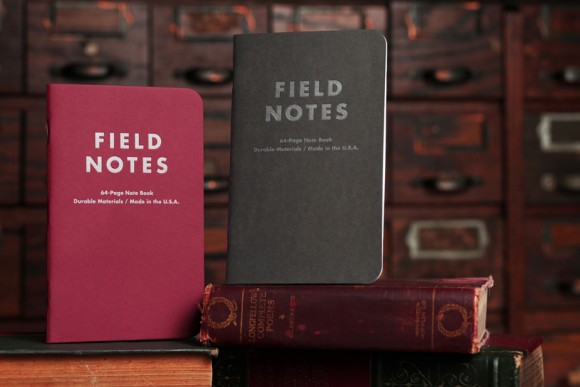
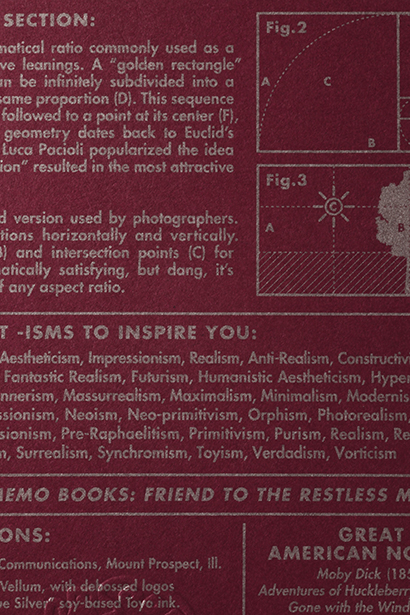 The “Arts” Note Book is designated for creative musings, featuring a wine-colored cover containing a wealth of handy information for writers and fine artists. Its 64 interior pages are quarter-inch ruled in “Academy Gray” for prose and poetry on the right-hand (“recto”) side, and blank on the left-hand (“verso”) side for sketches, scribbles, and sentence diagrams.
The “Arts” Note Book is designated for creative musings, featuring a wine-colored cover containing a wealth of handy information for writers and fine artists. Its 64 interior pages are quarter-inch ruled in “Academy Gray” for prose and poetry on the right-hand (“recto”) side, and blank on the left-hand (“verso”) side for sketches, scribbles, and sentence diagrams.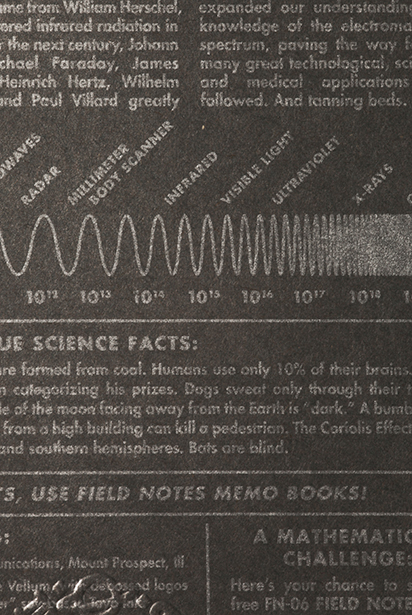 “Sciences” sports a dark slate gray cover loaded with the formulas, theories, and ideas you need to get you through your day. The recto pages feature an all-new “Engineer’s Graph” subdivided into one-inch, half-inch, and tenth-inch squares in “Academy Gray.” As with “Arts,” the “verso” side of the sheet is blank, awaiting your diagrams, calculations, and observations
“Sciences” sports a dark slate gray cover loaded with the formulas, theories, and ideas you need to get you through your day. The recto pages feature an all-new “Engineer’s Graph” subdivided into one-inch, half-inch, and tenth-inch squares in “Academy Gray.” As with “Arts,” the “verso” side of the sheet is blank, awaiting your diagrams, calculations, and observations